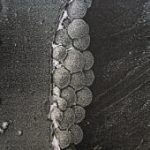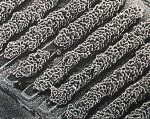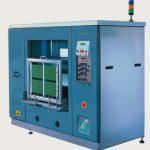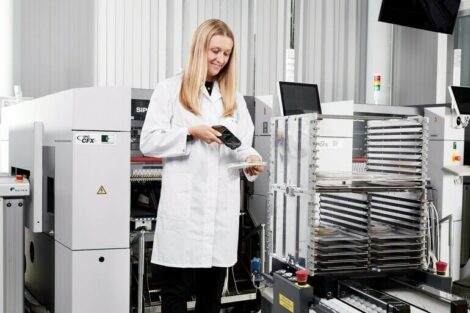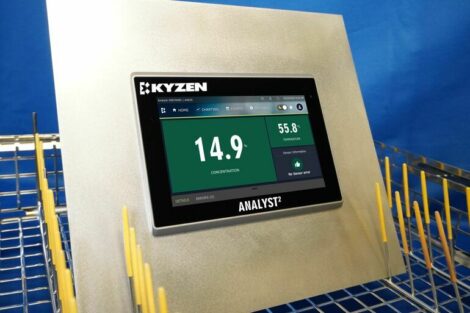Whether board assembly or printer stencil, soldering carrier or condensation trap, the cleanliness of each individual piece of equipment is important for the results in the manufacturing line. The cleaning process and the quality of this procedure determine the individual steps as well as the parameters.
However, before the appropriate cleaning procedure can be set, companies have to be alerted to the fact that a qualified cleaning is necessary to achieve higher process stability. This awareness is evolving more and more because the old saying that a chain is only as strong as its weakest link is also very true in a production chain. Thus, for instance, the latest stencil printer, the most expensive pick&place machine and the best reflow oven are not of much use if these are not sufficiently clean.
Statistics have shown that in SMT (surface-mount manufacturing) lines about 64% of all process-related defects can be tracked to deficits along the printing process. At this latest point of time it is superfluous to ask why printer stencils have to be thoroughly cleaned. If they have not yet been, failures in the reflow process are just around the corner. What is the reason for the disproportionately high potential of flaws around printing? To a large extent, it is because tools that appear clean at first sight are not. Particularly with fine-pitch components, details are no longer recognizable with the nak-ed eye.
Almost invisible
We already speak of ultra-fine pitch. These are components with an I/O grid of only up to 0,3mm. And whatever applies to technical refinement, also applies to residues or contamination, respectively. It is microscopically small yet present and does lead to defects. Almost invisible pollution causes a notice-able degradation in quality or leads to defects in manufacture. The process becomes vulnerable and instable, and, in the long run, financial los-ses are the consequence. Repeat-able quality becomes a question of luck, and capital investment in expensive up-to-date production lines is basically in vain. It can easily be assumed that the defect ratio of around 15% as in placement and soldering could likewise be in a similar range in stencil printing performance, if only it could be assured that perfectly clean stencils are be used. In reversal this means, almost 50% of process-related failures are due to – apart from normal wear and tear – not tolerable or insufficient cleaning of production tools. If 65% of the assembly defects can be tracked down to flaws which already occurred in the printing stage, then a clean stencil seems to be one of the most essential prerequisites for defect-minimized manufacturing performance.
As mentioned before, the naked eye is no longer a suitable control instrument. Having confidence in the human eyesight in many cases, however, users often state that the stencils are visibly uncontaminated, and a cleaning step therefore seems unnecessary. However, under the microscope, a completely different image shows up.
Current printers can easily manage to keep the underside of stencils tidy using tissue-based cleaning. Taking out the stencil after this cleaning, it looks optically dirt-free. This is a very superficial way of approaching the problem. In fact, a good printer with a suitable mechanism is capable of sufficiently and thoroughly cleaning the stencils during the process.
A suitable cleaning agent for the underside of printer stencils is mainly differentiated by the following characteristics: quick and residue-free solvent evaporation; high flash point ( >120°C), so that the printer will not have to be protected from ex-plosion; must be suitable for cleaning of both paste and adhesive, no negative impact on the viscosity of the SMT adhesive or its polymerization (precipitation hard-ening).
Stealthy contamination
The superficial cleanliness of stencils is unreliable. Even the best underside tissue cleaning can in no way achieve or guarantee the suitable cleanliness of the apertures. But this is not what the underside cleaning is supposed to achieve. A very serious potential for production defects exists here, and will develop with every print stroke. Nevertheless, solder residues can accumulate at the aperture walls, which the tissue can’t reach or remove.
Just take the edge of a stencil opening at high magnification. It may reveal that a considerable amount of solder alloy mixed with flux has built up in the aperture and has diminished its diameter considerably. Similar problems can likewise be found with SMT adhesive on stencils made of plastic. Due to the contamination-reduced diameter of apertures, after a short op-eration time disruptions in the solderpaste depot can be observed. The consequence: soldering flaws and thus almost predetermined production defects aregenerated, even before the board has reached a pick&place machine or reflow oven.
From this it becomes clear that perfectly cleaned stencils will almost completely prevent this kind of flaw. Therefore, underside cleaning in the printer must be completed by an external system, which can assure free apertures and thus the precision of fine-pitch apertures. Only then is a stencil clean beyond the optical image, and only then can the defect rate in the entire process be substantially minimized. Therefore a thorough cleaning of stencils at the end of each shift, changeover and possibly even during running production should be performed in a cleaning sys-tem working according to a double-sided spray principle.
Link of a chain
Taking for granted the necessary understanding for thorough cleaning, such systems have established themselves as equal members in a production chain side-by-side with paste printers, pick&place machines, reflow ovens and QA equipment. They guarantee that production tools are not only perfectly tidy, but due to the brief sequences that it will be available rapidly in the process again. Thus, the cleaning systems are not only part of the production chain, but likewise of the value-added-chain. They help gaining profit by reducing defects. While electrical test and optical inspection detects failures, cleaning equipment prevents that these defects develop at all. What applies to stencil cleaning is likewise relevant for a multitude of cleaning requirements in manufacture. By providing high cleaning standards, the process-related defects can be reduced by 50%. And this represents a tremendous potential for optimization in order to realize the maximum value possible.
Tidy assemblies
The cleaning of board assemblies and of misprints is also an issue of preventing the loss of a lot of money. An assembly bears at least one component that has been placed and soldered. Widely undisputed is the cleaning need for assemblies and misprints. (Even if it is not cheerfully admitted: the quantity of boards to be cleaned is substantially higher than of stencils.) If on the backside of a misprint, however, components have already been placed and soldered, we regard this as an assembly. This is a classical case: on one side of a double-sided board, the components have already been successfully placed and soldered. While paste printing or dispensing the second side, the need arises that this side might have to be cleaned of mistakes or faulty prints.
But what however happens to the already mounted components on the other side? They will inevitably be cleaned, but very often on an intolerable purity level. An assembly has higher demands in terms of the cleaning quality as a misprint, and therefore also higher requirements concerning the equipment and the cleaning detergent. Simply said: if a misprint is one side of a double-sided board, the higher the cleaning demands of this assembly. If this were not taken into account, a finished board would be likely to suffer or fail functionally. This kind of injury usually becomes visible by grayish to white „blossoming“ around the solder joints since they have been only partially freed of residues of resin, rosin or flux.
The widespread use of modern cleaning systems which can be used trouble-free has only been possible with aqueous, water-based cleaning agents. They can be applied in both in-line and stand-alone machines. Compared to the previously common cleaning systems operating with solvents, these formulations offer further advantages. In the meantime, there are aqueous systems available which have for instance been designed especially for the processing of solder frames and condensation traps and filters: these are mono-functional systems.
Water based systems
• Can be used close to the production line
• No explosion-protected area is necessary
• No exhaust is needed
• No offensive or even harming odors emerge
• Ecologically harmless
• 2-phase cleaning detergents can be replenished
Solvent systems
• Limited usage close to the production line
• Explosion-protected area is compulsory
• Exhaust system is mandatory
• Odors are offensive and even harmful
• Dangerous to environment
• Critical disposal of hazardous materials (solvents)
Mono or multi-functional?
There is, however, a clear trend towards cleaning systems which can provide solutions for all kinds of cleaning tasks – all in one piece of equipment with only one type of cleaning detergent. Such multi-functional systems can wash everything in the line. These are populated boards, misprints, stencils, soldering frames, machine parts, solder paste, (lead-free or leaded), SMT adhesive, flux residue or condensate. A 2-phase cleaning detergent (emulsion-cleaner to be replenished) can be used. The often-heard question of whether it is possible to solve all cleaning requirements with a single system is answered by such systems which combine latest technology with innovative detergents.
Other questions are: is „clean“ sufficient or does it have to be electrically clean? Which technology is the best? Rinsing with DI water or with a special medium? Us-ing a mono or a multi-functional system? Cleaning of stencils or populated boards and misprints? Or a cleaning system for populated boards and misprints, which is also suitable for the cleaning of stencils, soldering carriers and other tools? Answers to all these questions a user can find in co-operation with a trustworthy vendor of cleaning equipment who provides adequate pre-sales and application support.
The explanation for the effectiveness of such multi-functionality lies in the rather limited number and types of contamination: solder paste, SMT adhesive, resin or rosin and flux plus so-called simple pollution such as oil, grease, dust, etc. Only the boards are of a more complex nature. A succesfully solved cleaning task increases the first-pass yield and thus the overall margin in the manufacturing line. And it is easily possible to calculate amortization of capital investment as well as the technological and financial benefits of a cleaning system.
Zusammenfassung
Reinigen in der Baugruppenfertigung trifft selten auf große Gegenliebe. Deutlich wird dies an der Verfügbarkeit von No-Clean-Lotpasten aller Art, die entsprechend Anbieteraussagen nicht unbedingt entfernt werden müssen. Dennoch ist Reinigen nicht out, müssen doch Schablonenunterseiten kontinierlich sauber gehalten werden, gibt es Misprints oder Lötrahmen, die Abzuwaschen sind, sowie weitere Fertigungstools bei denen sich Sauberkeit auszahlt. Multifunktionale Reinigungsanlagen können eine wertvolle Hilfe sein.
Résumé
Le nettoyage dans la fabrication de modules suscite rarement l’enthousiasme, ce qui explique l’existence de toutes sortes de pâtes à braser sans nettoyage qu’il n’est, d’après les fabricants, pas indispensable d’éliminer. Mais le nettoyage n’appartient pas définitivement au passé car les dessous des pochoirs doivent être gardés propres en permanence et il est en outre nécessaire de nettoyer les ratés et de laver les cadres de brasage. Il existe par ailleurs des outils de production dont la propreté est payante. Les systèmes de nettoyage multifonctions peuvent représenter une aide particulièrement appréciable.
Sommario
Le operazioni di pulizia nell’ambito della produzione di gruppi costruttivi non sono particolarmente amate. Ciò si palesa dalla grande offerta di paste per brasatura „no-clean“ che, a detta dei produttori, non devono essere necessariamente rimosse. Ciò nonostante, la pulizia non è del tutto „out“. Infatti, i lati inferiori delle maschere devono essere tenuti continuamente puliti; vi sono poi misprints o telai di brasatura che devono essere sciacquati cosìccome molti altri strumenti di produzione che vale la pena tenere puliti. Degli impianti di pulizia multifunzionali possono rappresentare un valido ausilio.
Share:





